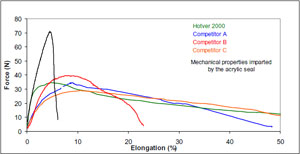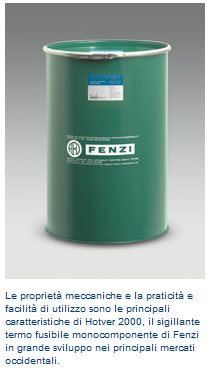The important factors to consider when selecting a hot melt sealant are mechanical properties, ease of application and moisture vapour transmission rates (MVTR). However when an IG design takes advantage of the reverse dual seal concept the priorities for the requirements of sealants take a slight turn in the sense that the MVTR and ease of application becomes more of a focal point over the mechanical properties.
Foam spacers with its low thermal conductivity and its ease of use have become a huge hit in the residential IG industry. The manufacture of such a high quality product is with the help of a very unique reverse dual seal design. According to a component supplier the system works because “a high performance acrylic pressure sensitive adhesive is used as a structural element in Edgetech’s Super Spacer system and it bonds directly to both lites of glass. The adhesive provides good tack and high shear strength for immediate adhesion and long term holding power. The acrylic adhesive has excellent UV stability and elevated temperature resistance. This structural seal is placed on the inside of the IGU and is protected by the moisture vapour seal (IG secondary sealant) on the outside”.
“Thus, in contrast to a conventional dual seal design, the insulating edge seal incorporating Super Spacer and secondary sealant is termed as a Reverse Dual Seal design, as the position of the structural and the moisture vapour/gas barrier seals are interchanged” . In order to understand the structural component of this claim we decided to dissect the reverse dual seal to quantify the structural support offered by the system and it turns out that the acrylic adhesive offers about 80% higher amount of support than a typical hot melt sealant applied 6mm deep i.e. approximately ¼ inch sealant depth. The following graph shows the mechanical properties of the major hot melt sealants sold in the IG industry and how it compares to one another versus how it stacks up against the acrylic adhesive offered by the foam spacer manufacturer.

It is evident that hot melt sealants are not offering much support and the structural success of this design lies in the abilities of the acrylic adhesive. However on the other hand this design begs for the ability of the hot melt sealant to act as a moisture vapour barrier. The following is a comparison of the most common hot melt sealants sold in the North American IG market.
ASTM E96/E 96M-10 Method A
Hotver 2000
Competitor A
Competitor B
Competitor C I
0 0.5 1 1.5 2 2.5
ng/Pa.s.m2 @ 2 mm
Hotver 2000 has the lowest MVTR and therefore makes it the most suitable sealant in conjunction with a reverse dual seal design. The sealant categories being equal, it is correct to say that being the best in MVTR, Hotver 2000, will also outperform competitors in gas retention. Furthermore Hotver 2000 has the lowest application temperature (290-340°F) all while maintaining similar flow rates and not causing undue stress on the components of the machinery which could cause premature wear and tear.
Insulating glass unit manufacturers should be careful when considering “value engineered” products because there is certainly a tradeoff. Blending high performance raw material with cheaper options reduce costs but also performances, such as MVTR and gas retention and not to mention the long term affects to the users of such products as well as to the environment. Fenzi has always been very conscious of the long term properties of its products therefore we pay specific attention when selecting our raw materials to ensure maximum longevity and the least impact on the environment and health of all stakeholders.










